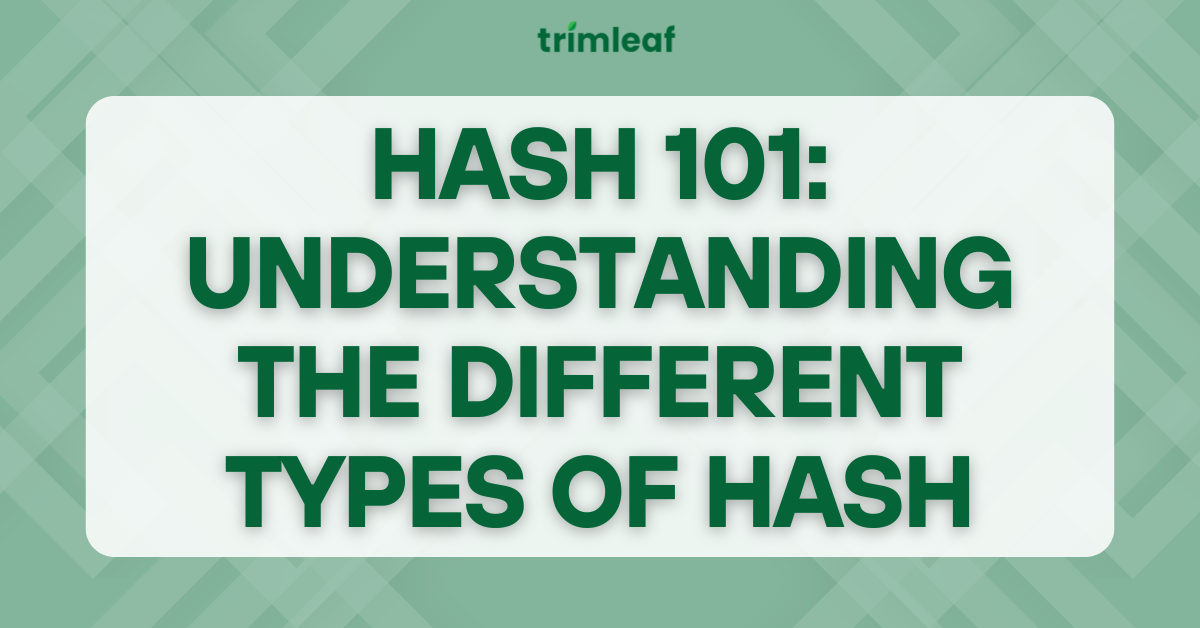
Hashish, more commonly known as hash, is one of the oldest and most celebrated cannabis concentrates in the world. Prized for its potency, rich flavors, and varied cultural significance, hash comes in many forms—each with its own method of production, texture, and effect. Understanding the differences between the types of hash can enhance your experience and help you make smarter choices.
In this guide, we’ll explore the most important types of hash, from classic hand-rubbed charas to the modern solventless innovations, as well as answer the most common questions people ask about hash today.
Table of Contents
- What Is Hash?
- Main Types of Hash and How They’re Made
- 1. Dry Sift Hash (Kief Hash)
- 2. Bubble Hash (Ice Water Hash)
- 3. Charas (Hand-Rubbed Hash)
- 4. Pressed Hash (Traditional Hashish)
- 5. Rosin (Hash Rosin & Flower Rosin)
- 6. Solvent-Based Hash (BHO, PHO, Etc.)
- How to Choose the Right Type of Hash
- Best Ways to Enjoy Hash
- Conclusion
- Frequently Asked Questions About Different Types of Hash
What Is Hash?
Hash is made by collecting the sticky, resinous trichomes from cannabis plants, which are then pressed into a solid mass. People worldwide prize hash for its potency, compact form, and rich flavor. While hash can be much stronger than regular cannabis flower, it also delivers a uniquely smooth and sometimes more aromatic experience. Trichomes contain the majority of the plant’s cannabinoids and terpenes, which give hash its potency and complex aroma.
Over hundreds of years, different cultures have devised their own ways to make hash, which has led to a wide range of textures, strengths, and flavors.
Main Types of Hash and How They’re Made
1. Dry Sift Hash (Kief Hash)

Dry sift hash, sometimes just called “kief hash,” is made by gently sifting dried cannabis buds over fine screens to separate the trichomes from the plant material. The resulting powder (kief) is then pressed using heat and pressure to form blocks or discs.
Key points
- Origin: Popular in Morocco, Lebanon, and parts of North Africa.
- Potency: Moderate to high, depending on the quality of the starting material.
- Best for: Smoking in joints, pipes, or blending with flower.
- Texture and appearance: Ranges from soft and pliable to powdery or crumbly, depending on the purity and pressure applied.
2. Bubble Hash (Ice Water Hash)

Water hash uses ice water and agitation to separate trichomes from the plant material. The mixture is filtered through a series of mesh bags (measured in microns), resulting in a collection of resin glands that can be dried and pressed.
Key points:
- Origin: Modern method, popularized in the 1990s.
- Potency: High, especially for full melt grades.
- Best for: Dabbing, vaporizing, or mixing with flower.
- Texture and appearance: Can range from sandy to sticky or greasy. High-quality “full melt” bubble hash will vaporize completely, leaving little residue.
3. Charas (Hand-Rubbed Hash)

Unlike other types of hash that use dried plants, charas is made by gently rubbing the fresh, live cannabis flowers between the palms. The sticky resin collects on the skin and is then scraped off and rolled into balls or sticks.
Key points
- Origin: India, Nepal, and the Himalayas.
- Potency: Moderate to strong, often with a unique, herbal flavor profile.
- Best for: Smoking in traditional chillums or joints.
- Texture and appearance: Soft, pliable, and often very sticky, with a rich dark color.
4. Pressed Hash (Traditional Hashish)

Pressed hash is usually created by collecting dry sifted trichomes and compressing them under heat, sometimes with the addition of a small amount of water or oil. The result is a dense, brick-like product.
Key points
- Origin: Afghanistan, Lebanon, Morocco, and Pakistan.
- Potency: Moderate.
- Best for: Smoking in pipes, bongs, or mixed with tobacco.
- Texture and appearance: Firm and brick-shaped, but can be soft or crumbly depending on moisture content and age.
5. Rosin (Hash Rosin & Flower Rosin)

Rosin is a newer, solventless extraction made by applying heat and pressure to either hash or cannabis flower using a rosin press. Hash rosin, in particular, is known for its exceptional purity and potency.
Key points:
- Origin: Modern extraction, gaining popularity in recent years.
- Potency: Very high.
- Best for: Dabbing or vaporizing.
- Texture and appearance: Sticky, glassy, or batter-like.
6. Solvent-Based Hash (BHO, PHO, Etc.)

Solvent-based hash like BHO are produced using solvents such as butane or propane to strip cannabinoids and terpenes from the plant. The resulting extracts (like shatter, wax, or crumble) are sometimes called “hash” but are more accurately referred to as cannabis concentrates.
Key points:
- Origin: Modern labs.
- Potency: Extremely high.
- Best for: Dabbing or vaporizing.
- Texture and appearance: Can range from glass-like shatter to soft wax or sauce.
How to Choose the Right Type of Hash
Choosing the best hash for you depends on your preferences and your intended use:
| Use Case | Recommended Hash Type | Why It Works |
|---|---|---|
| Traditional, mellow experience | Pressed Hash or Charas | Offers earthy flavors and a historical connection to ancient cannabis culture |
| Purity and potency without solvents | Bubble Hash or Rosin | Solventless, ideal for dabbing with high cannabinoid and terpene content |
| Versatile usage options | Dry Sift Hash | Can be sprinkled into joints, bowls, or pressed into rosin |
| Maximum potency | Solvent-Based Concentrates | Highest THC levels; best for experienced users — buy from trusted sources to avoid contamination |
💡Additional Tip: Think about how you want to consume hash and what matters most: flavor, strength, or tradition.
Best Ways to Enjoy Hash
Choosing the best way to consume hash can dramatically affect your experience. Whether you prefer the traditional route or a more modern approach, understanding the nuances of each can help you maximize enjoyment.
Smoking Hash

The classic way to enjoy hash is by mixing it with cannabis flower in a joint, pipe, or bong. This method is straightforward and enhances the overall flavor profile, combining the distinct taste of hash with your favorite bud.
The effects are almost immediate, making it easy to gauge your dosage. However, the density of some hash can make it harsh on the throat, and the combustion process creates smoke that may irritate your lungs.
Dabbing Hash

Dabbing involves vaporizing hash concentrates like bubble hash or rosin on a heated surface, typically using a dab rig or e-nail. This method delivers a potent and fast-acting high while preserving the hash's delicate terpenes and flavors.
Because it avoids combustion, dabbing is often considered less harsh on the lungs compared to smoking. However, it requires specialized equipment and may not be the best option for beginners because of the intensity of the effects.
Vaporizing Hash

Vaporizers designed for concentrates or flower can also be used to consume hash. This method offers a smooth and flavorful experience, with temperature control that helps preserve the cannabinoids and terpenes.
Vaporizing is more discreet and portable than dabbing, but the initial cost of a good vaporizer can be a barrier. Also, some vaporizers may struggle with very dense hash, so ensure your device is compatible.
Conclusion
Whether you’re drawn to the ritual of hand-rubbed charas or the cutting-edge purity of hash rosin, each type of hash offers a unique way to enjoy cannabis’s most prized compounds. Understanding the differences empowers you to choose the right hash for your needs, whether you’re looking for traditional flavors, high potency, or a specific consumption method.
Explore, compare, and always consume responsibly to get the best out of your hash experience.
Frequently Asked Questions About Different Types of Hash
- ◄What is hashish and how is it different from regular cannabis flower?
- Hashish, or hash, is a concentrated cannabis product made by collecting and compressing the plant’s resinous trichomes. It is more potent than regular cannabis flower due to its higher THC content and often delivers a smoother, more aromatic experience.
- ◄How is hash traditionally made?
- Traditional hash is made by separating trichomes from cannabis plants through methods like hand-rubbing fresh flowers (charas) or pressing sifted resin (dry sift hash) into blocks. These methods have been used for centuries in regions like India, Morocco, and Afghanistan.
- ◄What are the main types of hash available today?
- Popular types include dry sift hash, bubble hash (made with ice water extraction), charas, pressed hash, rosin, and solvent-based concentrates like BHO. Each varies in texture, potency, and flavor depending on its production method.
- ◄Can I make hash at home using dry sifting or ice water extraction?
- Yes, dry sifting and ice water extraction are beginner-friendly, solventless methods to make hash at home. Dry sifting separates trichomes using fine screens, while ice water extraction uses cold water and agitation to collect resin glands. Both require patience and clean equipment for best results.
- ◄What are the safest and most effective ways to consume hash?
- Hash can be smoked mixed with flower, dabbed using a rig or vaporizer, or vaporized directly. Smoking is traditional and accessible, dabbing offers potent and fast effects, and vaporizing provides a smooth, flavorful experience with less irritation.
- ◄Is hash more potent than other cannabis concentrates?
- Hash potency varies by type but generally contains higher THC levels than cannabis flower. Solvent-based concentrates like BHO can be more potent than traditional hash, but solventless options like rosin and bubble hash offer purity with strong effects.
- ◄Are there any health risks associated with consuming hash?
- When sourced from reputable producers and consumed responsibly, hash carries similar risks to other cannabis products. Using solvent-based concentrates made improperly can pose safety hazards, so always choose tested products and avoid homemade solvent extractions.
- ◄Does hash cause addiction or long-term health issues?
- Hash is not inherently more addictive than other cannabis forms. Like all THC products, it should be used in moderation. Long-term effects depend on frequency of use, individual health, and consumption method.
- ◄How do I store hash to maintain its quality?
- Store hash in a cool, dark, and airtight container to preserve potency, flavor, and texture. Avoid excessive heat, moisture, and light, which can degrade cannabinoids and terpenes over time.
- ◄What are common myths about hash that I should know?
- Common myths include that hash is just like smoking flower, that all hash uses harmful chemicals, or that it’s unsafe or addictive. In reality, many hash types are solventless, traditional, and safe when consumed responsibly.




